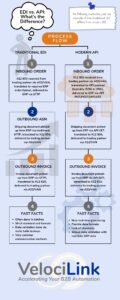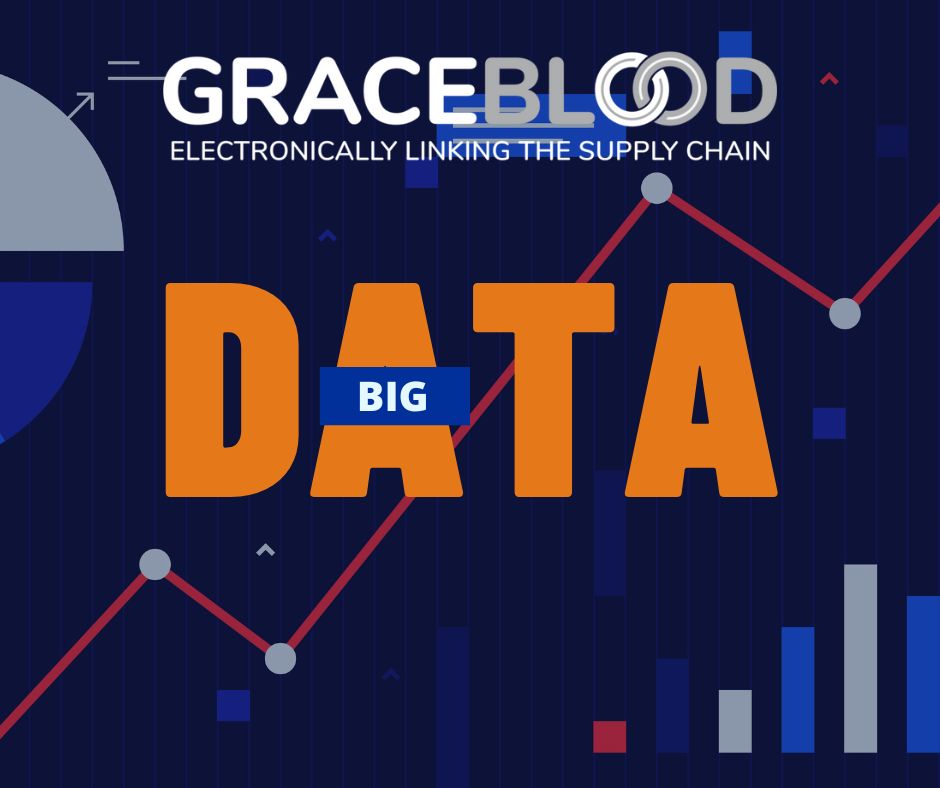
Updated 10/7/25
Businesses are constantly evaluating how to move information faster, smarter, and more securely. One of the most important technology comparisons shaping modern integration strategy is EDI vs. API—two foundational tools that define how organizations connect systems, partners, and processes.
This debate isn’t simply about which approach is superior. Instead, it’s about understanding the advantages and disadvantages of each, and how combining them can modernize supply chain operations. While EDI remains the backbone of structured communication, APIs bring flexibility and real-time access that reflect today’s on-demand economy.
At its core, the EDI vs. API conversation centers on data exchange and the key differences in how information moves between systems. EDI governs batch-based, validated document flows—ensuring accuracy and compliance—while APIs enable instant, event-driven exchange for web, mobile, and cloud applications. The future of integration lies not in choosing one, but in aligning both for maximum business impact.
Table of Contents
- EDI Advantages: Reliability, Efficiency and Compliance
- Understanding the Foundations of EDI and APIs
- Benefits of API Integration in the Modern Cloud
- EDI vs. API: Advantages and Disadvantages (Pros and Cons)
- Benefits of Combining EDI and API
- How EDI and APIs Work Together in Practice
- The Modern Cloud Approach to Integration
- The Role of EDI Expertise in Implementation Projects
- Why EDI Usage Remains Strong
Understanding the Foundations of EDI and APIs
Electronic Data Interchange (EDI) is the long-standing method of transmitting structured business documents—such as purchase orders, invoices, and shipping notices—between companies. It relies on global EDI standards like ANSI X12 or EDIFACT to ensure consistency, compliance, and interoperability across systems and industries.
EDI eliminates manual data entry, reducing errors, delays, and labor costs while creating an auditable record of transactions. It provides the dependability required in industries where timing and accuracy are crucial, such as manufacturing, healthcare, and retail.
Application Programming Interfaces (APIs), by contrast, are built for flexibility and real-time responsiveness. They enable systems to communicate directly by sending or retrieving data on demand. Understanding how APIs work is straightforward: they act as digital connectors that allow software applications to share information instantly without manual intervention.
APIs and EDI serve different purposes, but both drive efficiency. EDI technology enforces structure, while APIs promote adaptability—two sides of the same integration coin.
EDI Advantages: Reliability, Efficiency, and Compliance
Among the many EDI advantages, reliability stands out as its defining strength. Over decades of adoption, EDI has proven its ability to deliver validated, structured data consistently across global networks.
EDI also enhances efficiency by automating end-to-end workflows and reducing redundant processes. With documents automatically posting into ERP systems, teams spend less time reconciling mismatches and more time on strategic work.
Another major benefit is regulatory alignment. From HIPAA transactions in healthcare to EDIFACT standards in global trade, EDI ensures critical data meets partner and industry compliance requirements—something few technologies match.
Benefits of EDI for Supply Chain Operations
For retailers and distributors, this level of structure supports predictable operations, synchronized inventory, and dependable fulfillment. The benefits ripple across departments, improving collaboration between purchasing, logistics, and finance while strengthening trading partner relationships.
Benefits of API Integration in the Modern Cloud
The benefits of API integration are clear in the modern cloud environment, where businesses need real-time visibility and flexibility. APIs enable instant updates between cloud systems, making data accessible exactly when and where it’s needed.
APIs also improve collaboration by connecting front-end customer platforms with back-end operational systems. This eliminates data silos and speeds up decision-making—turning fragmented systems into connected ecosystems.
From a technical perspective, APIs don’t replace EDI—they extend it. While EDI handles high-volume transactional data exchange, APIs deliver responsiveness for software integrations. The two technologies together create a balanced, modern infrastructure.
Efficiency Gains Through API Integration
The result is operational efficiency. By linking ERP, logistics, and customer systems through APIs, companies can instantly relay shipping updates, product availability, or invoice statuses. This drives better service and fewer delays across their digital networks and marketplaces.
EDI vs. API: Advantages and Disadvantages (Pros and Cons)
Comparing EDI vs. API reveals distinct pros and cons. EDI systems deliver consistency, governance, and reliability. APIs provide immediacy, flexibility, and easy scalability. Each serves a vital purpose in supporting modern business demands.
The advantages of EDI include its proven structure, industry-wide adoption, and secure, auditable transactions. Yet it can be slower to update and less dynamic for time-sensitive scenarios.
APIs, on the other hand, offer agility but require continuous versioning, testing, and ongoing maintenance. Without governance, API sprawl can quickly create integration chaos.
Balancing the Benefits for Modern Integration
The best approach is hybrid: leveraging EDI for its control and APIs for its speed. This balance delivers the benefits of both, allowing companies to achieve operational excellence without compromising reliability or compliance.
What are the Differences?
While both aim for smooth data exchange between systems, they approach the task in very different ways. Below are some of their core differences:
EDI vs. API: How Do They Compare & What are the Differences?
While both aim for smooth data exchange between systems, they approach the task in very different ways. Below are some of their core differences:
| Feature | EDI | API |
| Data Transfer Speed | Batch processing; ideal for high-volume transactions with predictable schedules. | Real-time data exchange; better for immediate updates in dynamic environments. |
| Data Format | Standardized formats like ANSI X12 or EDIFACT; ensures consistency across systems. | Flexible formats like JSON and XML; adaptable but may lack standardization. |
| Integration Complexity | Proven and reliable setup for industries with strict requirements; expert support available. | Easier initial setup; may require more frequent adjustments or updates. |
| Scalability | Stable and dependable for established processes and large-scale operations. | Highly adaptable but may require ongoing development to keep up with changes. |
| Security Protocols | Uses robust protocols like AS2 or VAN; trusted for compliance in regulated industries. | Relies on web protocols like HTTP/HTTPS; effective but may require additional compliance measures. |
| Cost | Long-term reliability and value for high-volume, critical business operations. | Lower initial cost; better suited for less complex or smaller-scale integrations. |
Benefits of Combining EDI and API
When EDI and APIs are combined, organizations unlock the benefits of both worlds. APIs bring immediacy to EDI-driven workflows, while EDI ensures that core data exchanges remain standardized and compliant.
For instance, a warehouse may use EDI to transmit an 856 Advanced Ship Notice, while an API instantly updates a partner’s dashboard with delivery tracking details. This seamless integration supports transparency, accuracy, and customer satisfaction.
Combining these technologies bridges the gap between traditional systems and modern cloud platforms, creating a unified network of communication across trading partners, logistics providers, and marketplaces.
Efficiency and Benefits of Hybrid Exchange
The hybrid approach enables different applications to share synchronized data, eliminating redundancy and manual intervention. This improves efficiency, reduces cost, and keeps every stakeholder informed in real time.
How EDI and APIs Work Together in Practice
When orchestrated properly, EDI and APIs form a complementary ecosystem. EDI handles standardized transactional flows, while APIs enhance flexibility and access.
Middleware and integration platforms now serve as the glue between both technologies—routing EDI transactions through APIs to achieve unified monitoring, mapping, and reporting.
A manufacturer may process purchase orders via EDI while using APIs for customer status updates and analytics. This hybrid design ensures reliable EDI connections with the agility to support evolving business needs.
Data Exchange Efficiency in Hybrid Integration
Together, EDI and APIs create a single source of truth. EDI ensures accuracy and compliance, while APIs provide rapid updates. The combined system supports efficient data exchange across departments and partners, driving greater collaboration.
The Modern Cloud Approach to Integration
The migration toward modern cloud environments is transforming integration strategy. Cloud-based platforms allow businesses to consolidate API and EDI flows into one scalable system.
This approach simplifies partner onboarding, improves visibility, and reduces the complexity of legacy systems. It also lowers maintenance costs and enhances speed-to-market for new initiatives.
Cloud-based EDI solutions with built-in API functionality allow organizations to connect faster while maintaining compliance and control—key factors in achieving digital agility.
Benefits of the Modern Cloud Model
In this model, businesses gain the efficiency of automation with the confidence of structure, building a resilient foundation for future expansion and seamless integration across internal and external systems.
The Role of EDI Expertise in Implementation Projects
Successful integration requires technical skill and EDI expertise. Projects that involve both APIs and EDI demand thoughtful planning around mapping, error handling, and compliance.
An experienced partner ensures that both technologies align with business objectives, avoiding common pitfalls like data mismatches or security gaps.
Expert teams also handle testing, rollout, and long-term EDI implementation—making sure systems evolve smoothly without disrupting partner relationships.
Advantages of Expert-Led Integration
With the right guidance, companies streamline processes, reduce downtime, and ensure ongoing maintenance is handled efficiently. This expertise translates into faster ROI and stronger EDI integration success.
Why EDI Usage Remains Strong
Despite newer technologies, EDI usage remains strong across industries because it provides predictability, compliance, and integration depth. Its structured nature is ideal for repeatable, high-volume processes.
Embedded within ERP systems, EDI acts as the reliable engine driving daily B2B communication—from retailers and distributors to manufacturers and carriers.
Its continued dominance demonstrates that standardization still matters, especially when precision and accountability are essential for business success.
Benefits and Efficiency in Supply Chain Operations
EDI provides the benefits of streamlined workflows and reduced rework. Its efficiency in handling routine documents ensures companies maintain accurate records, dependable deliveries, and satisfied partners.

Addressing the API Debate
The API debate often suggests that APIs will replace EDI, but in practice, APIs amplify EDI’s strengths. APIs improve usability and visibility, but EDI provides the discipline, security, and compliance that enterprises rely on.
Businesses that focus exclusively on APIs risk integration sprawl and inconsistent data governance. Meanwhile, EDI’s format-driven control maintains integrity across thousands of partner connections.
Pros and Cons of a Unified Strategy
The future lies in uniting both technologies. When deployed strategically, APIs and EDI work together to accelerate decision-making—combining the pros and cons of each into one resilient system.
This hybrid integration ensures seamless integration across internal systems, external networks, customer-facing platforms and other applications—achieving the agility modern organizations demand.
Moving Beyond the EDI vs. API Debate
EDI vs. API is not a competition but a collaboration. EDI ensures secure, standardized communication for mission-critical operations, while APIs deliver speed, flexibility, and real-time responsiveness. By combining both, companies can modernize their ecosystems, improve data exchange, and unlock the next generation of supply chain agility.
Speak to one of our experts to find out EDI integration with modern API innovation create smarter, more connected, and future-ready supply chains through truly seamless integration.








